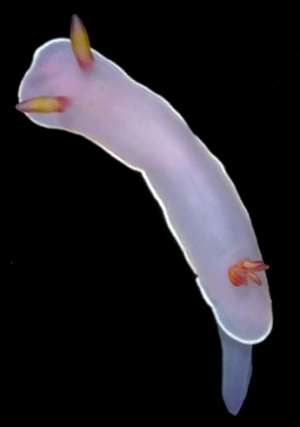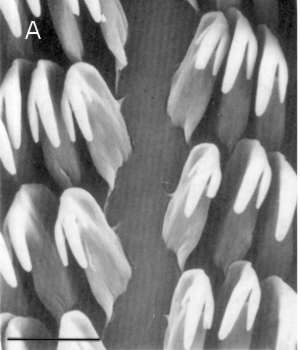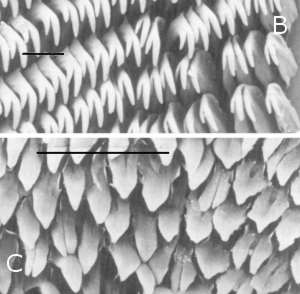
Thorunna punicea
(Rudman, 1995)
Order: NUDIBRANCHIA
Suborder: DORIDINA
Superfamily: EUDORIDOIDEA
Family: Chromodorididae
DISTRIBUTION
Known only from New Caledonia
PHOTO
Upper right: Channel, Passe de Koumac, 20 40.7'S, 164 14.7'E, 66-87m, dredged in mixed shell sand and mud, NW New Caledonia, HOLOTYPE, 12mm long alive, 24 October 1993, AM C200618 (in MNHN, Paris). Photo: Bill Rudman. Lower: SEM photos of the radula. A, Central region of radula showing Thorunna-like tricuspid innermost lateral teeth. B. Section of radula showing inner half of left side. Note bicuspid Hypselodoris-like lateral teeth. C, jaw rodlets. Passe de Koumac, New Caledonia, 12mm long alive, (AM C200618). Scale bars = 25 µm. Photo: A.C. Miller.
The mantle is a bluish purple with a pinkish tinge anteriorly, between the rhinophores. There is a thin opaque white line right at the mantle edge. The rhinophore stalk is wine-red, the colour diffusing on the basal part of the club. The rest of the rhinophore club is yellow except for the upper few lamellae which are purplish red. The knob at the tip of the rhinophore is translucent clear. The simple gills are translucent clear with a yellowish tinge. The line along the outer edge of each gill is orange on the basal half, and red on the upper half. The line along the inner edge of each gill is red. The change from orange to red along the outer edge is very diffuse. The foot and underside of the body is a uniform bluish purple, somewhat darker than that of the mantle.
The mantle is elongately oval, somewhat broader anteriorly, giving the body a spatula-like shape. The body is relatively high and the mantle overlap not greatly developed into a skirt. It has similarities in shape to species of Hypselodoris and Risbecia. There are no signs of mantle glands. There are eight simple gills arranged in a circlet, open posteriorly, around the anus. The two most posterior gills are smaller than the others. The gills vibrate rhythmically as the animals crawls along.
When I described this species there were a number of puzzling anatomical features which suggested that the species was not a species of Hypselodoris but perhaps a species of Thorunna or even Durvilledoris. In particular, features of the reproductive system, the absence of mantle glands and vibratile gills were all characteristic of Thorunna. The innermost lateral teeth are also quite characteristic of Thorunna. In Gosliner & Johnson's review (1999) of Hypselodoris, this species is moved to Thorunna, a decision which I fuller agree with.
-
Gosliner, T.M. & Johnson, R.F. (1999) Phylogeny of Hypselodoris (Nudibranchia: Chromodorididae) with a review of the monophyletic clade of Indo-Pacific species, including descriptions of twelve new species. Zoological Journal of the Linnean Society, 125: 1-114.
-
Rudman, W.B. (1995) The Chromodorididae (Opisthobranchia: Mollusca) of the Indo-West Pacific: further species from New Caledonia and the Noumea romeri colour group. Molluscan Research, 16: 1-43.


Rudman, W.B., 2005 (February 1) Thorunna punicea (Rudman, 1995). [In] Sea Slug Forum. Australian Museum, Sydney. Available from http://www.seaslugforum.net/factsheet/thorpuni
Related messages
-
Thorunna punicea again [2]
From: Colin Ogden, April 25, 2008 -
Thorunna punicea again [1]
From: Colin Ogden, April 25, 2008 -
Re: Thorunna punicea? from South Africa
From: Colin Ogden, March 22, 2007 -
Re: Thorunna punicea? from South Africa
From: Colin Ogden, March 21, 2007 -
Thorunna punicea? from South Africa
From: Colin Ogden, March 19, 2007
